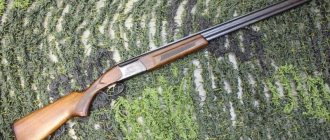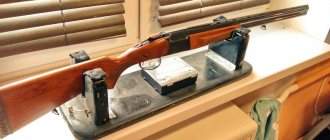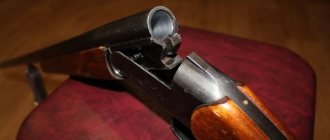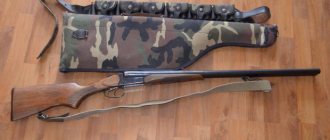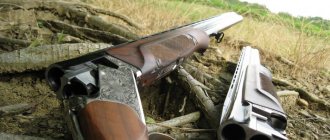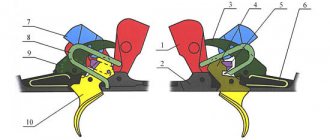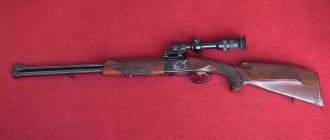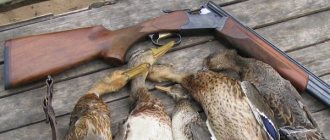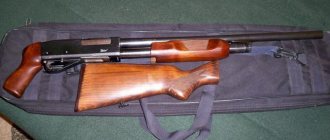MC – Model TsKIB-a, legendary sporting and hunting weapon. MC shotguns have repeatedly received medals at various international exhibitions, but this is not the main merit of MC shotguns. MC 108 - this gun won two Olympics, in the classical disciplines of Skeet and Trap, one of them with an absolute Olympic record of 150 out of 150 (2000, Sydney). The MTs 8 shotgun and its modifications MTs 8 -2, MTs 8 -03, MTs 8 -01 are considered the standard of a sports shotgun; countless world and European championships have been won with it.
The legendary shooter Durnev performed with this gun, and the MTs 8 gun helped Petrov win the Olympics on the skeet. MTs 6 and its later modification MTs 106 were both sporting shotguns and high-quality hunting weapons. The MTs 7 is known as an exclusively hunting rifle; it was awarded to the Soviet party nomenklatura and leaders of foreign states during the USSR. It is known that Fedel Castro is the owner of the MC hunting carbine.
A separate “caste” of high weapons are the models MTs 9, MTs 109, MTs 11 and MTs 111 . MC TsKIB produced only a few such guns.
The development of sports weapons began in 1948 with the creation of the MTs1 sports pistol, and already at the XV Olympic Games in 1952 in Helsinki, Tula weapons brought the first gold and silver medals. In total, at the Olympic Games, World and European Championships and Cups, athletes shooting from MC weapons won 136 gold, 112 silver and 83 bronze medals.
Purpose and technical characteristics
The MTs 8-2 double-barreled sports shotgun (Fig. 1) is intended for shooting with appropriate shot primarily at fast-moving targets in sports shooting ranges. For 12 gauge rifle cartridges.
Detachable trunks are located in a vertical plane. Barrel length 750 mm.
The barrel channels have special choke constrictions that ensure hitting targets at ranges from 25 to 50 meters. The barrels are connected to the frame by means of a barrel coupling, a hinge, a latch, a transverse pin and a locking frame. The stock is walnut with protrusions for the hand and under the cheek. The forend is secured to the barrels with screws.
The hammer mechanism with internal triggers and the trigger mechanism with two triggers are mounted on a single separate base.
The front trigger is designed to fire a shot from the lower barrel. The hammers are cocked simultaneously during the process of unlocking and opening the barrels.
The cartridges are pushed out of the barrel chambers using a common ejector. To reduce the likelihood of unexpected shots, there are special fuses.
The outer surfaces of the box are decorated with engraving and embossing.
The weight of the gun is from 3.6 to 3.8 kg.
Instructions for using the gun
Interaction of parts when unlocking and opening barrels.
To unlock and open the gun barrels (Fig. 2), you need to move lever 4 to the extreme right position with your right hand and then turn the barrels 1 around the hinge axis 17 with your left hand.
In the process of turning the lever to the extreme right position, the wedge-shaped frame 15 that locked the barrels will move to the rear position and release the barrel coupling 1, the lever arm will disengage the transverse pin 2 from the barrel hooks, and the rocker 5 connected to the frame will turn the triggers 7 onto the safety hooks.
To hold the lever in the extreme right position, there is a stop (not shown in the figure), located in the wall of the box slot on the left side. If it is necessary to move the lever to the axial position, press the stop with a drift.
When the barrels are opened, the pushers 16 will move back, and the cocker 3 connected to them will put the hammers in the firing position. In this case, the mainspring 10 will be compressed, the sear 14, under the action of the trigger spring 11, will jump behind the cocking hammers. At the same time, the cocker will turn the rocker, rod 6 will move the safety button 8 to the rearmost position, safety 9 will prohibit triggers 12, 13. Before firing a shot, it is necessary to move the safety button to the rearmost position.
Incomplete disassembly and reassembly of the gun.
Partial disassembly is carried out for inspection, cleaning and lubrication of the gun.
Disassembly sequence.
For separating barrels from the box from the stock; (Fig. 3) it is necessary to pull the latch 2 of the barrels down, move the lever 5 to the extreme right position, turn the barrels 1 by about 15 until the ejector pins 4 align with the corresponding grooves of the box 3, and then remove the barrels from the box up.
To separate the trigger mechanism from the box and stock (Fig. 4) it is necessary:
unscrew the bracket screw 4 from the stock 6, and then the bracket 8 from the hole in the base of the trigger mechanism 5;
unscrew the front screw 2 of the box shank from the hole in the base of the trigger mechanism and the rear screw 3 from the hole in the box shank;
unscrew the screws 7 of the trigger mechanism base from the hole in box 1;
separate the trigger mechanism from the box and then the box from the stock.
Reassemble the gun in the reverse order.
Complete disassembly and reassembly of the gun.
Complete disassembly is allowed in cases of extreme necessity and is carried out only in a weapons workshop.
Disassembly sequence.
To disassemble the barrel assembly (Fig. 5) it is necessary:
unscrew the lining screws 10, the stock screw 3 and separate the linings 2 and 6 from the barrels 1;
unscrew the barrel latch axis 5 from the hole in the clutch 1, separate the barrel latch 8 and the lock 9 with spring 7, and then remove the ejector 4 by hand.
To disassemble the box assembly (Fig. 6) you must:
push the rod axis 21 out of the hole of the button 15, rod 14 and separate the spring 18 with cap 19 from the box 7;
unscrew the lever screw 6 from the hole in the lever axis 13, separate the lever 9 and the lock 4 with spring 3;
push out the lever axis and remove the strikers 12 with springs 11 from the box hole;
remove from the box the locking frame 20 with the rocker arm 16 and the rod, the transverse pin 2 of the settings 8 with the spring 5;
push the pin 22 out of the hole of the button 15 and separate the spring of the button 17 and the button from the shank of the box 7;
remove cocker 1 and remove pushers 10 from the box.
To disassemble the firing mechanism (Fig. 7) you must:
holding the trigger with 1 finger, press triggers 9, 11 and release the triggers from the safety hooks;
push the spring pin 8 out of the hole in the base of the firing mechanism 7 and remove the mainspring 6 and the trigger spring 12;
push the trigger axis 4, the sear axis 10 and the fuse axis 5 out of the holes in the base of the trigger mechanism and separate the triggers, the sear 2, the triggers and the fuse 3 from it.
Reassemble the gun in the reverse order.
When connecting the barrels to the box, you need to turn the latch down, move the lever to the extreme right position and put the barrels into the box so that the ejector pins fit into the corresponding grooves of the box, and the barrel coupling fits onto the hinge of the box and can be secured with a latch.
After assembly, check the interaction of the gun mechanisms.
Read cyber fiction online on Phantom Worlds
MAKSIMOV.SU
Hunting and sporting rifles under the MC brand –
a special topic for conversation.
One can admire TsKIB weapons, but they do not forget to scold them. These guns have a complex and very interesting history, coupled with the almost closed specifics of production, which gave rise to many legends, myths and other tales of the “but I heard it” type. about MC guns
, but it is sometimes impossible to get answers to specific questions even from TsKIB masters. But you can pick up the MC, shoot it, compare it with other guns and think about it. And there is something to think about...
MTs-8 shotgun
with interchangeable barrels
I’ll make a reservation right away - it’s difficult to get the most plausible information about TsKIB guns. Almost impossible. Today's craftsmen either do not want to reveal interesting facts about their work and the history of the enterprise, or, oddly enough, they simply do not always know the answers to all the questions.
The famous TsKIB is still one of the most conservative enterprises of our defense industry, with all the expiring features of its work. Despite all the numerous forecasts, TsKIB did not close, and, unlike thousands of enterprises of the former USSR, continues to operate.
Of course, the inevitable problem of personnel and the “failure” of the 1990s also occurred at the eminent enterprise, which often has a positive effect on the quality of work of the once impeccable TsKIB. But many Tula defense enterprises operate quite successfully.
TsKIB also lives. There is also a site for repairing hunting weapons, which makes it possible to breathe new life into old “MC-guns,” delighting the owners and warming us with hope for the speedy revival of a manufacturer of elite weapons that competed on equal terms with the best gunsmiths in the world.
A lot has been written about MTs guns and I would not like to repeat myself, even if this concerns the unique MTs-8 copy, in its state of preservation and configuration, that illustrates this article.
But, omitting the well-known nuances of the design of this model, some aspects of the production history of MC shotguns, apparently, should be discussed in more detail. Gun MTs-8, engraving
Looking for the best
When talking about comparing shotguns under the MC brand and a whole range of top-level hunting weapons from foreign manufacturers, you need to take into account and understand much of what is usually, consciously or not, overlooked.
Firstly, domestic weapons have always had initial parameters that differ from the “generally accepted” Western ones. The simplest example is the creation and design features of our three-line rifle, the concept of which was noticeably different from the European concepts of an army magazine.
You don’t have to go far here - this applies to everything from tanks to ideology.
We create everything for our conditions, taking into account both climatic specifics and the characteristics of domestic industry. And our mentality, of course. Blind copying is unacceptable, as the practice of reforms of Peter the Great showed. Shotgun MTs-8, interchangeable barrels
Everything that has ever been created in the largest and coldest country in the world, in Russia, was produced without taking into account the more “greenhouse” Western criteria, although, of course, not without taking into account the latest achievements of its neighbors.
Remember our first Zhiguli? What remains of Fiat in them? After all, everything has been redone! And all because the European car was adapted to our climate and industrial capabilities, which is an extremely competent approach. Otherwise, the “penny” would not have survived with us.
Gun MTs-8,
engraving
As for the analytical identification of the most rational and applicable in one’s own conditions, this is a normal world practice. Therefore, you should not be surprised that we borrowed the best and modernized it to suit our conditions and tasks, often obtaining completely new technical solutions and, unique to us, conceptual directions.
Gun MTs-8,
engraving
All this also concerned the development of sporting and hunting weapons in the USSR. Taking from Western samples the best of what suited the specifics of our production, the level of personnel training and the identified prospects for the development of our weapons school, we were able to quickly lay a powerful production and intellectual foundation on which the inimitable family of guns produced by TsKIB was created.
Gun MTs-8,
engraving
We had someone to learn from, fortunately we had the desire. There was a need for this, and the virtual teachers were good. German, English and other gunsmithing schools, which grew up on vast experience in the production of high-quality hunting weapons and a developed production base, could afford the design and manufacture of truly high-quality guns.
Of course, we remember very well such our geniuses as Gonno, Maslova, Matska and others, but they usually were more involved in assembling high-class guns, using ready-made European-made barrels.
MTs-8 shotgun,
engraving, interchangeable barrels, top view
Russia, which never had colonies like England, could not allow its nobles to develop this kind of aristocratic entertainment, such as exotic hunts in various regions of the world.
Accordingly, there were no such volumes of production of adequate hunting weapons - from cage guns to African rifles. Most of the guns came to us from Europe. Which, however, suited almost everyone for the time being.
Shotgun MTs-8,
barrel breech
The domestic arms industry, almost always working for the needs of the army, could not afford to be fully distracted by the production of hunting weapons (however, for hunters, especially fishermen, it was quite enough for inexpensive and reliable guns made from old army rifles).
Even in Soviet times, the same TsKIB always remained in the structure of the defense industry, unable to fully concentrate on the production of high-class sporting and hunting weapons.
Gun MTs-8,
engraving
But, during the times of the USSR, our athletes were not comfortable shooting from foreign-made guns. However, as well as performing in foreign teams, as for some reason this is quite acceptable in our time. And even today everything is not so simple - we cannot see the forest for the trees and advertising often gives us a pass to the desired world, instead of the real one.
Gun MTs-8,
engraving
And in the distant post-war years, the reality was much more harsh and unambiguous, which some researchers sometimes play on, for the sake of words, telling gullible readers about the allegedly repressed (by personal order of L. Beria, of course) sports leadership of the USSR, which allowed the use of foreign guns by Soviet athletes.
Gun MTs-8,
engraving
The Central Design Research Bureau for Sports and Hunting Weapons (TsKIB SOO), created in 1946 under TOZ, was originally intended to develop and create new directions in the field of sports and hunting rifles.
As a higher school of weapons craftsmanship, as a kind of research institute for rifle production, which has in its weapons museum a huge amount of weapons from all over the world. At least that's what they say. But this, in any case, is quite logical, and in the Research Institute of the Ministry of Internal Affairs and the Shot courses, for example, there is definitely such a “selection”.
Gun MTs-8,
engraving
But we should not forget that, unlike Western companies leading in the field of hunting weapons, TsKIB was part of our military-industrial complex, developing and producing military and special small arms, which also could not but influence the specifics of the created samples and production technology.
Of course, the concentration of personnel from the Soviet arms industry in the Bureau in no way excluded the traditional close study of foreign weapons. Which is the reason for various kinds of insinuations about TsKIB and the circulation of false myths about blind copying of Western designs.
Gun MTs-8,
engraving
It is necessary to understand that every known model of small arms, no matter a Mauser rifle, a Kalashnikov assault rifle or the latest modifications of the M-16, is always created by a team of designers, but not by a lone genius.
Weapons are always designed for a specific technical specification, for a specific cartridge, and not from scratch. Therefore, all TsKIB weapons are the natural result of long and painstaking work, including an empirical creative search for the best ways to solve the assigned tasks, which have never been ordinary for the Bureau.
Gun MTs-8,
engraving
The USSR had experience in the production of large-scale hunting weapons. And more than successful. For the most part, these were wonderful models that are still popular among hunters. And the very first samples of MC double-barreled guns earned great fame, thanks to their phenomenal survivability and unsurpassed reliability, remarkable performance qualities and the highest quality of assembly and finishing.
Over the entire history of TsKIB, only about 20 thousand copies of guns and carbines were assembled at the enterprise. Some models have left a deep mark not only in the domestic, but also in the world history of hunting and sporting weapons. One of these guns was rightfully the MTs-8, which was born in 1953, already far from us.
Shotgun MTs-8
When mentioned
about the truly legendary “eight”, any connoisseur will tell you about the incredible survivability of this model, with which our athletes have won Olympic gold more than once, and some examples of which have been fired at a mind-boggling figure of a million or more shots, with full-weight 32-gram loads.
It was this gun that served as the reason for the fables of the “experts” that it was not in vain that the “reparation” Germans worked for us and our MTs-8 is just an exact copy of “some kind of Merkel”, forgetting about what kind of enterprise and why the G8 was developed and what was the numerical and qualitative composition of the Bureau’s employees in the 1950s.
MTs-8 shotgun,
barrel muzzles
Probably, the design of the MTs-8 embodied all possible technologies and design sophistications that were known at that time, contributing to the achievement of maximum survivability of the design and the achievement of the highest results in shooting sports.
Everything was used: the highest quality steel with unique characteristics, and the enormous work of a large team of the best designers, all the current achievements of science and technology, combined with the jewelry skills of assemblers, were taken into account.
Certain design details of the MTs-8 later became imitations on Western sporting shotguns. But some elements of the design of our gun, taking into account their complexity in manufacturing and fitting, involving a large amount of highly skilled manual labor, remained unattainable for Western competitors.
MTs-8 shotgun,
sights
Of course, the most important and unsurpassed feature, one of the components of the fantastic survivability of the “eight”, was the “dead hinge”, proprietary to TsKIB, through which the gun barrels are connected to the receiver.
The wedge-shaped frame, which reliably fixes the barrel coupling when the barrels are closed and is the main element of the famous MTs-8 locking, is complemented by upper locking elements made in the form of easily recognizable “fangs” located on both sides of the breech of the upper barrel.
Connecting the breech parts of the barrels using a combined method, combining both demi-block and monoblock elements, is “low-lifting” even for rich and well-equipped industries. Difficult to comprehend, from the standpoint of a simple hunter or a “not advanced” shotgun shooter, is the specific design of the MTs-8 barrels, which forgives mistakes when shooting at a stolen target.
And so on, and so on, and so on, making this gun one of the best sporting guns in the world. Perhaps the best, if you evaluate the “eight” by its “classmates”. Even today, the MTs-8, which has excellent maintainability, almost regardless of condition, is a coveted acquisition for connoisseurs.
Shotgun MTs-8
But, of course, the most important asset of TsKIB was and remains the people who live by weapons and have dedicated their lives to it. Today, in the era of mass production of guns on CNC machines, when 100% interchangeability of parts has been achieved and even engraving has long been done not by hand, the most advanced Western gun cannot be called a piece product, because it is a product of machine production.
This also applies to English guns today. Probably, on the one hand, this is not even bad, because... ensures relatively reliable and very long-term operation of the double-barreled shotgun.
But these guns do not have a “soul”, they do not carry the warmth of the hands of the craftsmen who create truly one-of-a-kind guns, which are all, without exception, weapons with the MC brand, created entirely at TsKIB. Which, by the way, is also something most Western manufacturers cannot complain about.
Dead hinges
on the MTs-6 and MTs-106 guns
Stand exhibitors know a lot of examples of the short life of modern sporting shotguns from famous companies, but few have even heard of such problems with MC shotguns. Especially for the “eighth” model. Therefore, MTs-8, despite its 57-year production history, is still in service.
And especially, in addition to collectors and hunters, it is appreciated by those stand exhibitors for whom it is not necessary to have advertising of the manufacturer’s name on the barrels of his gun. What is significant is that the MTs-8 is highly valued by such Western shooters as Michael Yardley, Rasmunsen and other people well-known in the arms world, who sometimes own several copies of the MTs-8. And they are not shy about admitting it openly.
Epilogue
TsKIB, contrary to numerous forecasts and statements, is by no means dead. At the moment, there are about 40 serious developments on smooth-bore weapons alone, which are still “under the carpet.” And, after the upcoming modernization of production, a lot of this will definitely be embodied in metal.
So, remembering the well-known Russian proverb that “chickens are counted in the fall,” it is too early to make rash statements about the gloomy prospects of the elite Russian design bureau.
MTs-8 against the backdrop of the Black Sea
The article was published in the magazine "Master Gun"

